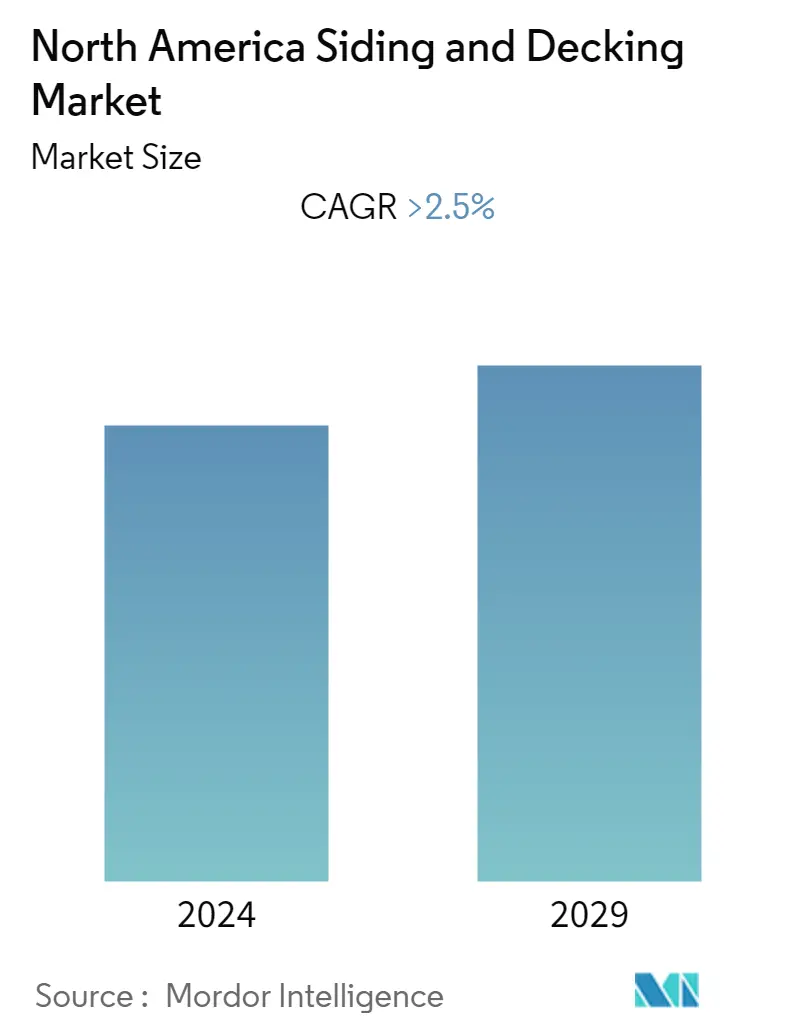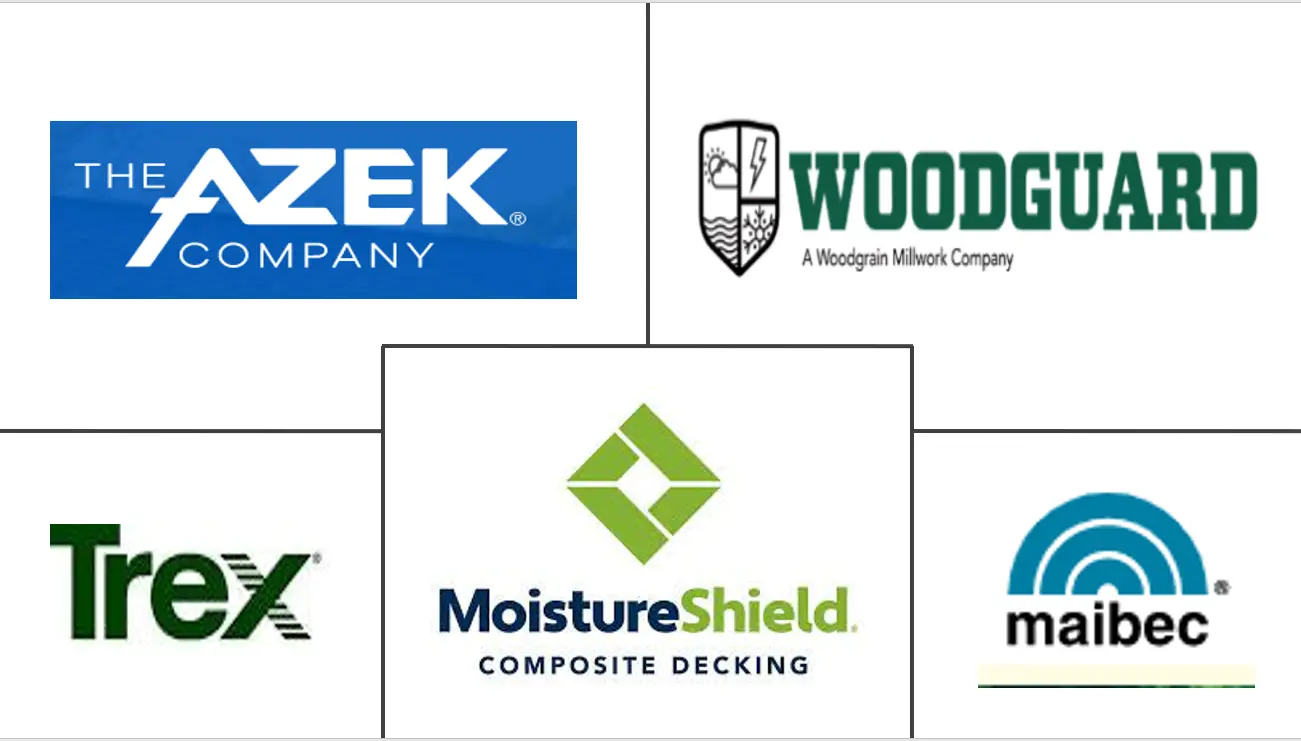Market Size of North America Siding and Decking Industry

| Study Period | 2020 - 2029 |
| Base Year For Estimation | 2023 |
| Forecast Data Period | 2024 - 2029 |
| Historical Data Period | 2020 - 2022 |
| CAGR | > 2.50 % |
| Market Concentration | Medium |
Major Players
*Disclaimer: Major Players sorted in no particular order |
North America Siding & Decking Market Analysis
The North American siding and decking market are quite vibrant and prosperous and there have been many developments in the industry that are expected to continue into the future. The North America Siding and Decking Market is expected to witness growth at a CAGR of nearly 2.5% during the period 2020-2026.
The siding and decking market has experienced healthy growth during the past decade and was on pace for continued growth in 2020 before disruptions from the coronavirus (COVID-19) set in. The North America siding and decking industry is facing several challenges as it deals with the impact of the COVID-19 pandemic such as contraction of new construction activities and reduced discretionary spending impact on building material categories, including siding and exterior trims. However, sheltering at home clearly influenced demand, amongst U.S. homeowners and have done some type of home improvement project during the pandemic during 2020. The home goods and remodeling markets have benefited during the pandemic from increasing interest in do-it-yourself and outdoor living projects as residents found new ways to stay busy amid lockdowns and travel restrictions and over the final quarter of 2020 companies like Trex witnessed a rise in sales of residential products by nearly 40% on a year-over-year basis. With many homeowners having reduced budgets due to layoffs, furloughs, or COVID-influenced salary cuts, lower cost materials such as vinyl, could benefit the most in the short-term in the market.
North America is one of the key regions globally for the siding and decking market. Being one of the largest economies, the United States and Canada rule the decking industry. The increase in residential construction around states such as Georgia, Florida, Utah, Tennessee, Ohio, Idaho, and South California has also fuelled the increasing demand for the siding and decking market in the region.
The growing interest of consumers to live outdoors is one of the major factors fuelling the growth of North America siding and decking market. This is proving to be beneficial because more people are looking forward to enhancing and expanding the living space which is further contributing to increasing the value of the house by adding a deck. The homeowners in the region are more focused on creating a large and elaborate space containing features such as walls, fire pits, pergolas, outdoor kitchens, and others.
The demand for wooden decking is gradually rising across North America subject to the mounting residential construction activities in the United States and Canada in conjugation with the renovation of old buildings.The market is also witnessing high demand of sustainable decking materials such as wood fibre as these products employ recycled materials and therefore also benefit from a positive environmental profile. Furthermore, the local and state governments in the US are focused on using green materials for public construction projects. This, however, is being implemented in the siding and decking market as well to encourage the use of lumber produced from wood fibre and recycled plastic.
North America Siding & Decking Industry Segmentation
Siding and decking play an essential role in the protection of buildings. A complete background analysis of the North American Siding and Decking Market which includes an assessment of the economy, market overview, market size estimation for key segments, and emerging trends in the market, market dynamics, and key company profiles are covered in the report. The North America siding and decking Market is segmented by Type (Wooden Decking, Plastic Decking, Aluminium Decking, Composite Decking), by Siding Material (Vinyl, Fibre Cement, Wood, Metal, Stone, Others), By End User (Residential, Commercial, Non-Building/Non-Residential), and By Geography (United States, Canada). For each segment, the market sizing and forecasts have been done based on value (USD million).
| By Type | |
| Wooden Decking | |
| Plastic Decking | |
| Aluminium Decking | |
| Composite Decking |
| By Siding Material | |
| Vinyl | |
| Fibre Cement | |
| Wood | |
| Stone | |
| Metal | |
| Others |
| By End User | |
| Residential | |
| Commercial | |
| Non-Building / Non-Residential |
| By Geography | |
| United States | |
| Canada |
North America Siding and Decking Market Size Summary
The North American siding and decking market is experiencing a dynamic phase, characterized by a robust growth trajectory and significant developments. The market, driven by the increasing interest in outdoor living spaces and home improvement projects, has shown resilience despite challenges posed by the COVID-19 pandemic. The pandemic initially led to a contraction in new construction activities and reduced spending on building materials. However, it also spurred a surge in home improvement projects as homeowners sought to enhance their living spaces while sheltering at home. This trend has been particularly beneficial for lower-cost materials like vinyl, which have gained popularity due to budget constraints faced by many homeowners. The market is further bolstered by the growing demand for sustainable and eco-friendly materials, such as wood fiber, which align with the increasing consumer preference for environmentally responsible products.
The United States and Canada dominate the North American siding and decking market, with the U.S. construction industry playing a pivotal role in driving demand. The market is witnessing a shift towards composite and plastic lumber, which offer advantages over natural wood in terms of performance and maintenance. Residential decking, both in new constructions and as replacements, constitutes a significant portion of the market, with treated wood and wood-plastic composites being popular choices. The competitive landscape is marked by the presence of key players like Trex Company, Inc., and MoistureShield, who are actively expanding their product offerings and distribution networks. Government initiatives and projects in Canada, such as the Affordable Housing Initiative, are also contributing to market growth. Overall, the North American siding and decking market is poised for continued expansion, driven by evolving consumer preferences and ongoing construction activities.
North America Siding and Decking Market Size - Table of Contents
-
1. MARKET DYNAMICS & INSIGHTS
-
1.1 Market Overview
-
1.2 Market Drivers
-
1.3 Market Restraints
-
1.4 Market Opportunities
-
1.5 Value Chain Analysis
-
1.6 Porter's Five Forces Analysis
-
1.7 Insights on Government Regulations in the Market
-
1.8 Insights on Technological Trends and Innovations in the Market
-
1.9 Impact of COVID 19 on the Market
-
-
2. MARKET SEGMENTATION
-
2.1 By Type
-
2.1.1 Wooden Decking
-
2.1.2 Plastic Decking
-
2.1.3 Aluminium Decking
-
2.1.4 Composite Decking
-
-
2.2 By Siding Material
-
2.2.1 Vinyl
-
2.2.2 Fibre Cement
-
2.2.3 Wood
-
2.2.4 Stone
-
2.2.5 Metal
-
2.2.6 Others
-
-
2.3 By End User
-
2.3.1 Residential
-
2.3.2 Commercial
-
2.3.3 Non-Building / Non-Residential
-
-
2.4 By Geography
-
2.4.1 United States
-
2.4.2 Canada
-
-
North America Siding and Decking Market Size FAQs
What is the current North America Siding and Decking Market size?
The North America Siding and Decking Market is projected to register a CAGR of greater than 2.5% during the forecast period (2024-2029)
Who are the key players in North America Siding and Decking Market?
Trex Company Inc, The AZEK Company, Moisture Shield, Wood Guard and Louisiana Pacific Corporation are the major companies operating in the North America Siding and Decking Market.

